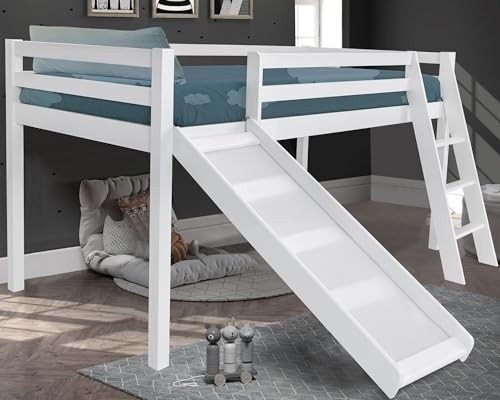Bunk Beds for Kids: A Comprehensive Guide
Bunk beds have been a popular choice for children's bed rooms for several years. They offer a space-saving service that makes the most of flooring location, offers fun climbing alternatives, and is available in a variety of styles that attract children's creativities. This article explores the advantages, considerations, designs, and security features connected with bunk beds for children.
Benefits of Bunk Beds
Bunk beds present numerous advantages that make them an attractive alternative for families. Here are some essential benefits:
Space Saving
- Bunk beds allow two or more children to share a space without compromising space for play or other activities.
Economical
- Getting a single bunk bed can be more affordable than buying 2 different beds.
Fun Factor
- Kids often see bunk beds as an enjoyable place to sleep and play, promoting a sense of adventure.
Adaptability
- Bunk beds are readily available in numerous setups, including L-shaped, loft beds, and even convertible designs that can change as children grow.
Organization
- Many bunk beds feature built-in storage alternatives, such as racks and drawers, assisting keep rooms arranged.
Key Considerations Before Purchasing
Before investing in a bunk bed, it's vital to consider certain aspects, such as:
- Space Requirements
Procedure the space to ensure that there suffices vertical space, enabling appropriate headroom on the top bunk. - Age of Your Children
Consider their age and maturity. Bunk Beds Children's advise that kids under 6 should not sleep in the top bunk due to safety concerns. - Weight Limit
It's vital to check the weight limits of the bunk bed for both the top and bottom bunks to ensure safety. - Style Preferences
Choose a design that matches the room's design and the children's choices. - Material
Bunk beds are offered in various products, such as wood or metal. Each has its benefits and downsides regarding durability and aesthetic appeals.
Styles of Bunk Beds
Bunk beds come in numerous styles to fit different looks and practical requirements. Here's a list of some popular designs:
- Standard Bunk Beds
Timeless stacked beds that include 2 beds constructed one above the other. - Loft Beds
A bed elevated high off the ground, with space underneath for a desk, play location, or storage. - L-Shaped Bunk Beds
2 beds arranged in an L-shape, offering more flooring space and a distinct style aspect. - Twin Over Full Bunk Beds
These alternatives feature a twin bed on leading and a full-sized bed on the bottom, accommodating older kids or adults. - Triple Bunk Beds
Developed for 3 kids, these beds normally consist of 3 stacked beds, ideal for bigger households.
Safety Features to Consider
Ensuring the safety of children using bunk beds is paramount. Here are some security includes to try to find before buying:
- Guardrails
A bunk bed need to include sturdy guardrails on the top bunk to prevent accidental falls. - Ladders
Guarantee that the ladder is safely attached and simple for children to browse safely. - Stability
Try to find bunk beds with lower centers of gravity and wide bases to supply much better stability. - Quality Construction
Pick beds made from long lasting products that satisfy safety standards, such as ASTM (American Society for Testing and Materials) policies.
FAQs About Bunk Beds
1. What age is appropriate for a leading bunk?Generally, children aged six and older are suggested for sleeping in the top bunk. 2. Are bunk beds safe for toddlers?Most experts recommend versus
positioning toddlers in the leading bunk due to the
risk of falls and inappropriate ladder usage. 3. Can bunk beds be separated?Many bunk beds are designed to be separated into 2 standalone beds,
supplying added versatility as kids grow
. 4. How do I maintain a bunk bed?Regularly check for loose screws and wear, keep mattresses clean, and make sure that the bunk bed is
steady to prolong its lifespan. 5.
Are there any unique bed mattress requirements for bunk beds?Yes, bed mattress for bunk beds must fit comfortably without leaving gaps. Typically, thinner bed mattress
(around 6 to 8 inches )are recommended for top bunks for safety. Bunk beds use a flexible, useful, and fun option for children's sleeping arrangements, taking full advantage of space while accommodating several kids in one room. By considering the essential aspects
of style, safety, and space, moms and dads can make an informed decision when picking the right bunk bed for their children's requirements. With the ideal care and maintenance, a bunk bed can be a cherished piece of furniture that offers years of use and enjoyment for children. Summary Table of Bunk Bed Styles Style Description Best For Standard Bunk Beds Traditional design, 2 stacked beds Smaller sized rooms Loft Beds Raised bed with open space underneath Study or play locations L-Shaped Bunk Beds 2 beds in an L-shape
Added floor space Twin Over Full Twin on the top,
| complete on bottom Accommodating older kids Triple | ||||||
|---|---|---|---|---|---|---|
| Bunk Beds | Three stacked beds | Larger families By understanding | the numerous options offered, designated considerations for security and functionality, and proper age guidelines, families | can choose the ideal bunk bed that not | only boosts their home | however also makes sure a safe and |
| satisfying sleeping environment | for their kids.

|
